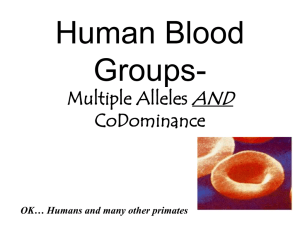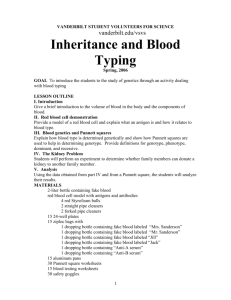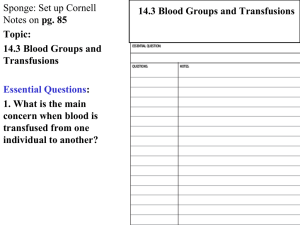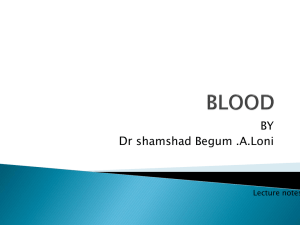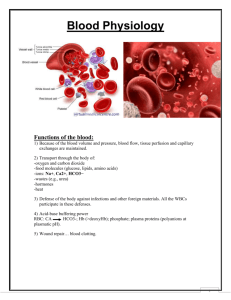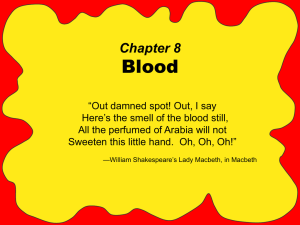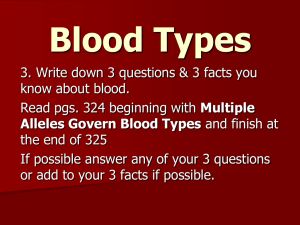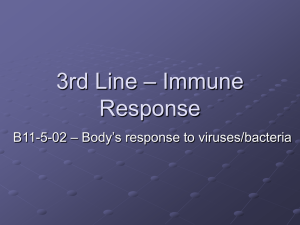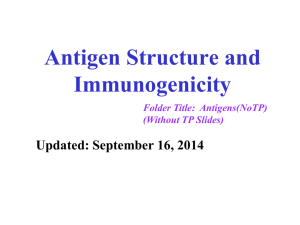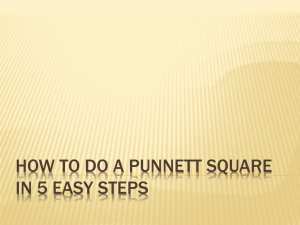Training - Powerpoint
advertisement
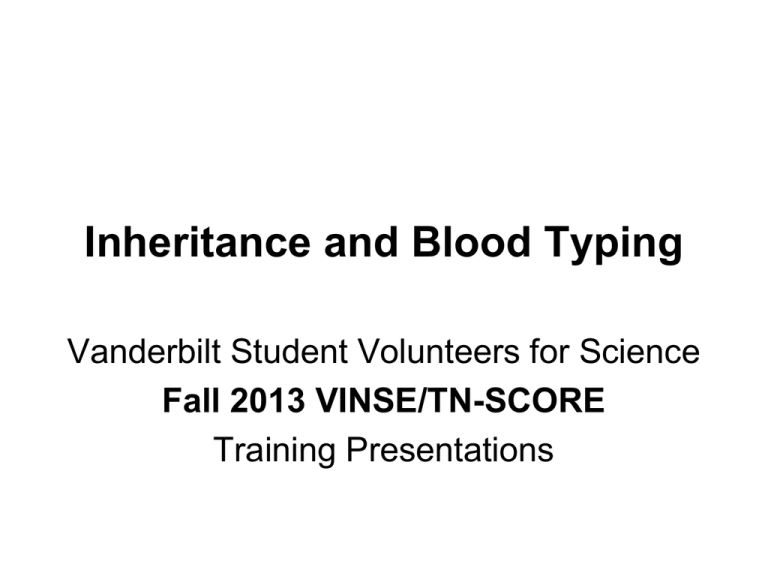
Inheritance and Blood Typing Vanderbilt Student Volunteers for Science Fall 2013 VINSE/TN-SCORE Training Presentations Important!!! • Please make sure that the students understand that there is no real blood in this lesson. • All solutions are made from chemicals. I. Introduction • How much blood is in the human body? – About 5 liters What is in blood? – – – – Red blood cells (RBC) White blood cells (WBC) Plasma Platelets • What is blood type? – A way to characterize what kind of proteins are present on someone’s red blood cells. – .It is determined by the type of antigen that is present on the surface of the red blood cells II. Red Blood Cell Demo • • • • • • • • Show the students the red styrofoam balls and tell them that they represent red blood cells. RBCs have proteins on their surface that determine what blood type a person is—these proteins are called antigens. The pipe cleaners are the antigens (pink is the “A” antigen, blue is the “B” antigen). Jab a ball with a pink pipe cleaner. This red blood cell now has the “A” antigen and is an A blood cell. Jab a blue pipe cleaner into another red ball. This RBC has a “B” antigen and is a B blood cell. Make an “AB” blood cell with both a pink and blue pipe cleaner. Ask the students what a RBC with NO antigens (no pipe cleaners) would be called? (“O”). Tell students to look at the handout to see a comparison of the different types of blood cells and the relative representation of blood types in the American population. ANTIBODIES • If a person’s RBC have one type of antigen (A or B), then their blood contains antibodies to the missing antigen. – eg. If the persons RBC has “A” antigens, then they will have antibodies against the “B” antigen. • Tell students to look at the Table in the handout. ABO Blood Type A B AB O Contains Antigen A yes no yes no Contains Antigen B no yes yes no Contains Antibody anti-A no yes no yes Contains Antibody anti-B yes no no yes http://anthro.palomar.edu/blood/ABO_system.htm • Antibodies help in removing unwanted things from the body. • • • Antibodies will attack and destroy any transfused or transplanted blood cells with that antigen. People need to have their blood tested before receiving someone else’s blood. When blood is donated, the plasma and the RBCs are separated. This ensures that the antibodies (in the plasma) don’t get transferred during the transfusion. ANTIBODIES cont. • If a person has blood type A, then he cannot receive Type B or Type AB blood because the Anti-A antibodies will bind to the A antigen and tell the body to destroy these cells. • Ask students if they can determine what types of blood a person with Type B blood can receive? O and B. • Ask students if they can determine what types of blood a person with Type AB blood can receive? A, B, AB, O. This person is called a universal recipient. • Ask students if they can determine what types of blood a person with Type O blood can receive? – Only O. But this person can give blood to anyone and is called a universal donor. III. The Kidney Problem • Read the kidney scenario in the manual. • Remind the students that the blood samples are not really blood. • Students will test the presence of antibodies by adding Anti-A and Anti-B serum to each person’s blood sample. • A sample is positive for an antigen by observing whether agglutination (clumping) occurs. – If the blood clumps for the anti-A serum and not the anti-B serum, then the blood type is A. – If it clumps for the anti-B and not for the anti-A, then the blood type is B. – If it clumps for both, the blood type is AB. – If there is no clumping, then the blood type is O. III. The Kidney Problem (cont.) • Divide the students into pairs. Pass out safety goggles to each student and one set of materials to each pair of students. • Have students add a squirt Mrs. Sanderson’s samples to the first two wells in column A. Add 5 drops of anti-A (blue) to the first well in column A (A-1). Observe whether a precipitate (or cloudiness) occurs - record a “+” if it does, or a “-” if it does not. Add 5 drops of anti-B (yellow) to the 2nd well in column A (A-2) and record the results. Repeat with Mr. Sanderson’s samples to the first two wells in column B, with Jill’s samples to the first two rows in column C and with Jack’s samples to the first two rows in column D Tell the students to determine the blood type of each person. • • IV. Analysis • The data tables show that Mrs. Sanderson has type A. • This means that she has antibodies that attack B antigens. • The family member who donates to her must not have B antigens in order to avoid this. • Therefore, Jack, with blood type O, can donate a kidney to his mother. V. Blood Genetics and Punnett Squares -Optional • Antigens and thus, blood type, are determined by the genes that get passed on from someone’s parents. – Explain that each parent (and each person) has two blood type alleles. This is what’s known as a genotype, or what genes are in someone’s body. Each parent will pass on one of these genes to their child. • These genes are for the A antigen, B antigen or no antigen (O). – The combination of two of these genes will result in blood type. • Punnett squares can be used to help figure out the possible inherited genetic trait combinations, like blood type (see example on next slide). • Review the terms dominant, recessive and co-dominant Punnett Square (Optional) • Filling in the Punnett Square: – The mother’s genes(AA) are placed on top of the Punnett square with each gene situated over one column. – The father’s genes (AB) are placed to the side with each gene next to its own row. – One of the mother’s A genes is written in each square below it; similarly, the other A gene is placed in the squares below it. – The father’s A gene is written in both squares to the right of it, as is the B gene. • This process is a simulation of genotypes their children could inherit. – In other words, there is a 50% chance a child will be AA and a 50% chance a child will be AB. Amother Amother Afather AA AA Bfather AB AB Dominant and Recessive Genes • In the case of blood, the A and B genes are co-dominant. This means that if a child inherits both an A gene and a B gene, both A and B antigens will be found on the surface of an RBC and the phenotype will be AB. • Individuals who have an AO genotype will have an A phenotype. • People who are type O have OO genotypes. In other words, they inherited a recessive O allele from both parents. Possible Genotypes • Ask students what each family member’s possible genotype is. Write these answers on the board and/or share with the class. Column A Column B Column C Column D Mrs. Sanderson Mr. Sanderson Jill Jack Row 1 Anti-A serum (+ / -) Yes No Yes No Row 2 Anti-B serum (+ / -) No Yes Yes No Blood Type (A, B, or O) A B AB O Possible Genotype AA or AO BB or BO AB OO Dominant and Recessive Genes cont. 1. Tell students to look at the Punnett square on the Handout. Parent Alleles The possible ABO alleles for one parent are in the top row and the alleles of the other are in the left column. Offspring genotypes are shown in black. Phenotypes are red in the brackets. A B O A AA (A) AB (AB) AO (A) B AB (AB) BB (B) BO (B) O AO (A) BO (B) OO (O) http://anthro.palomar.edu/blood/ABO_system.htm Ask students: If Jack has type O blood, what are the genotypes for his mother and father? Have the students fill out their Punnett square using all the possible genotypes for Mr. and Mrs. Sanderson. Clean-Up • Empty all the liquids from the well plates and rinse out with water (into a sink). • Return all items to the kit and bring back to the lab

